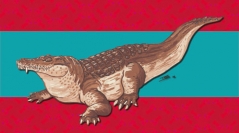

 Geodiversitas
46 (6) - Pages 135-326
Geodiversitas
46 (6) - Pages 135-326Crocodyliformes Hay, 1930 represents an important group of archosaurs that is currently restricted to twenty-eight species of semi-aquatic ambush predators. However, the extensive fossil record of Crocodyliformes indicates this group was much more diverse in the past and had a complex evolutionary history, rhythmed by a series of extinction events. An iconic expression of this past diversity is the colonization of the marine realm by several crocodyliform lineages, most notably by Thalattosuchia Fraas, 1901 during the Early Jurassic-Early Cretaceous and by Dyrosauridae de Stefano, 1903 during the Late Cretaceous-Early Eocene. Thalattosuchia constitutes by far the most spectacular and speciose marine radiation of Crocodyliformes, colonizing several ecological niches, before mysteriously going extinct during the Early Cretaceous. Dyrosauridae is well known for massively surviving the end-Cretaceous mass extinction, but disappearing soon afterwards. How crocodyliformes evolved to occupy marine niches and why they went extinct outside the marine extinction events of the Mesozoic is a mystery. Indeed, despite a good fossil record, postcranial elements of thalattosuchians and dyrosaurids have long been disregarded, withal several modern works during the past century. Attention has been focused, for years, on craniodental adaptations and feeding styles only, overlooking the swimming-related adaptations recorded in the postcranial skeleton that permitted these radiations. This work consists of a new thorough comparative description of the pelvic girdle of the most representative members of two extinct clades of aquatic crocodyliforms: Thalattosuchia and Dyrosauridae. This work also provides a standardize terminology and orientated of pelvic elements in those clades. This works does not aim at refining the taxonomy or cladistics of Thalattosuchia and Dyrosauridae, but will certainly clear the way for such future more specific endeavors. This work focuses on the postcranial morphology of Thalattosuchia and Dyrosauridae and aspires to shed light on pelvic evolution throughout their histories. Lastly, this work intends to highlight the relations between form and function within the postcranium of Thalattosuchia and Dyrosauridae, in order to better understand the locomotor habits or limitations present among the members of those extinct groups.
Archosauria, postcranium, anatomy, locomotion, appendicular morphology, ilium, ischium, pubis